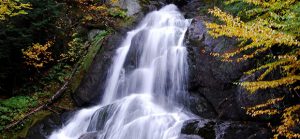
What Makes Vermont the Greenest State in the U.S.
April 22, 2016
Recycling, composting, buying local, and a genuine love for the land are values and practices that are a way of life in Vermont. Vermont consistently ranks as one of the greenest states in the country. Of course, we’re not exactly perfect. The state needs to reduce phosphorus pollution in Lake Champlain, wind power continues to be a contentious issue, and lack of public transportation in rural areas forces people to rely heavily on their cars.
Still, there’s a lot to be thankful for here. In honor of Earth Day, here are five reasons to celebrate conservation efforts in Vermont.
No Billboards
Vermont passed a landmark anti-billboard law in 1968 and the Green Mountains have been billboard-free ever since. The law was the result of the efforts of lawmaker and activist Ted Riehle, who was determined to preserve the natural beauty of Vermont. When you cross the state line into Vermont from New York or New Hampshire or Massachusetts, it immediately feels different. The lack of billboards is one of the reasons why.
Renewable Energy in Burlington
Burlington is the first U.S. city to run on 100 percent renewable electricity for its residents’ electricity needs. The city is acquiring its energy in diverse ways, from biomass and hydroelectric to solar and wind. Burlington Electric Department has aggressive energy efficiency programs and says it uses less electricity now than it did in 1989, according to ecowatch.com. Burlington also has several charging stations for electric vehicles.
The Gift of Granville Reservation
 One of the most unique areas of Route 100 is Granville Gulf Reservation, a remote, six-mile stretch of road between Granville and Warren. The area’s most popular attraction is Moss Glen Falls, a stunning waterfall. Most of the reservation’s 1,171-acres were donated in 1927 to the state by former Vermont Governor Redfield Proctor Jr., who stipulated that the land be forever protected and preserved. What a gift.
One of the most unique areas of Route 100 is Granville Gulf Reservation, a remote, six-mile stretch of road between Granville and Warren. The area’s most popular attraction is Moss Glen Falls, a stunning waterfall. Most of the reservation’s 1,171-acres were donated in 1927 to the state by former Vermont Governor Redfield Proctor Jr., who stipulated that the land be forever protected and preserved. What a gift.
Seventy-five Percent Forested
Vermont landscape is 75 percent forested, and the state is the fourth most forested state in the United States. Forest clearing became widespread around 1800 as Vermont farmers became suppliers of wood products, food, and wool to a rapidly growing nation. By 1860 less than one-half of the state remained forested and Vermonter George Perkins Marsh, arguably the nation’s first environmentalist, warned of the impacts of soil erosion due to forest clearing. While the forestland has been significantly restored since the 19th century (starting in the 1940s), It’s worth noting that Vermont’s forestland is now seeing a decline. Since 2007, the state has lost about 75,000 acres of forest, or about 1.6 percent, according to the U.S. Forest Service. You can learn more about George Perkins Marsh at the Marsh-Billings-Rockefeller National Park in Woodstock.
A Commitment to Protecting the Landscape
The Vermont Land Trust has permanently conserved since 1977 more than 1,900 parcels of land covering more than 550,000 acres, or about nine percent of the private, undeveloped land in the state. This conserved land includes more than 900 working farms and farmland parcels, hundreds of thousands of acres of productive forestland, and numerous parcels of community land. Drive along Pleasant Valley Road in Underhill Center or Taylor Farm in Route 11 in Londonderry to get a taste of the land trust’s impressive conservation efforts.
Happy Earth Day!




Scott
Posted at 14:25h, 22 AprilVery cool. Indeed, the billboard thing is very obvious especially near the boarder. Its funny though heading into VT from NY many of the billboards are for Vermont businesses. 🙂
On the point of Forest coverage, its interesting to see some of the old pictures where the lack of trees was stunning compared to today. You can find the old stone walls in the woods which (I assume) marked property that was once cleared and used for farmland. Without that context, the location of stone walls in the woods doesn’t make sense!
Erica
Posted at 14:47h, 22 AprilHi Scott — I know — seeing Vermont businesses advertising on billboards in NY and elsewhere is a little odd. The old photos of the cleared forests are incredible. That makes sense about the stone walls, too. I love coming across old stone walls in the woods! Hope all is well. -Erica
Alex
Posted at 19:49h, 29 AprilLove Vermont, can’t wait to visit again this summer!
Someone should calculate a “Trees to tailpipes ratio”
I think Vermont would do well, the air is amazing!
Erica
Posted at 19:50h, 29 AprilVery true, Alex! I hope you have a great visit this summer. Thanks for saying hello!